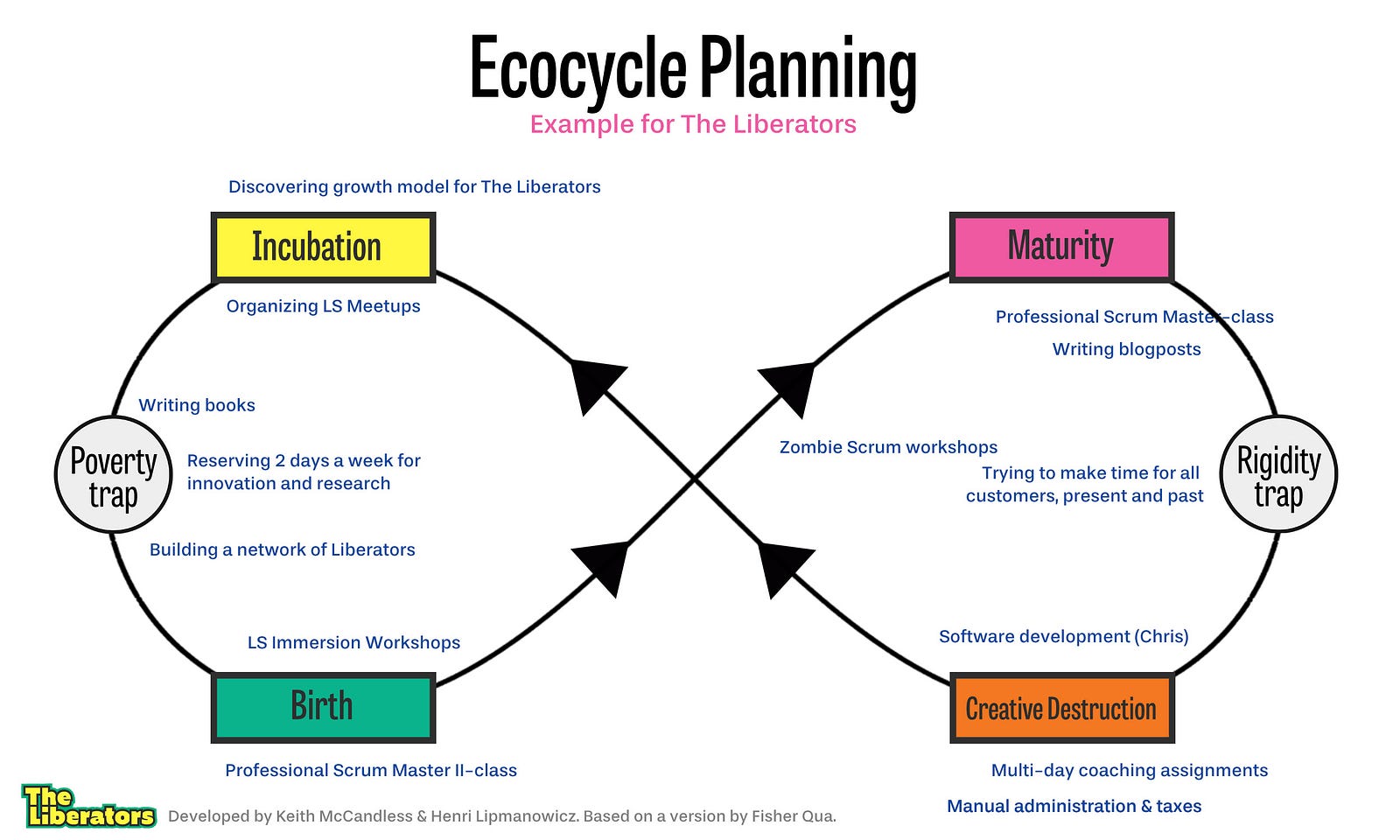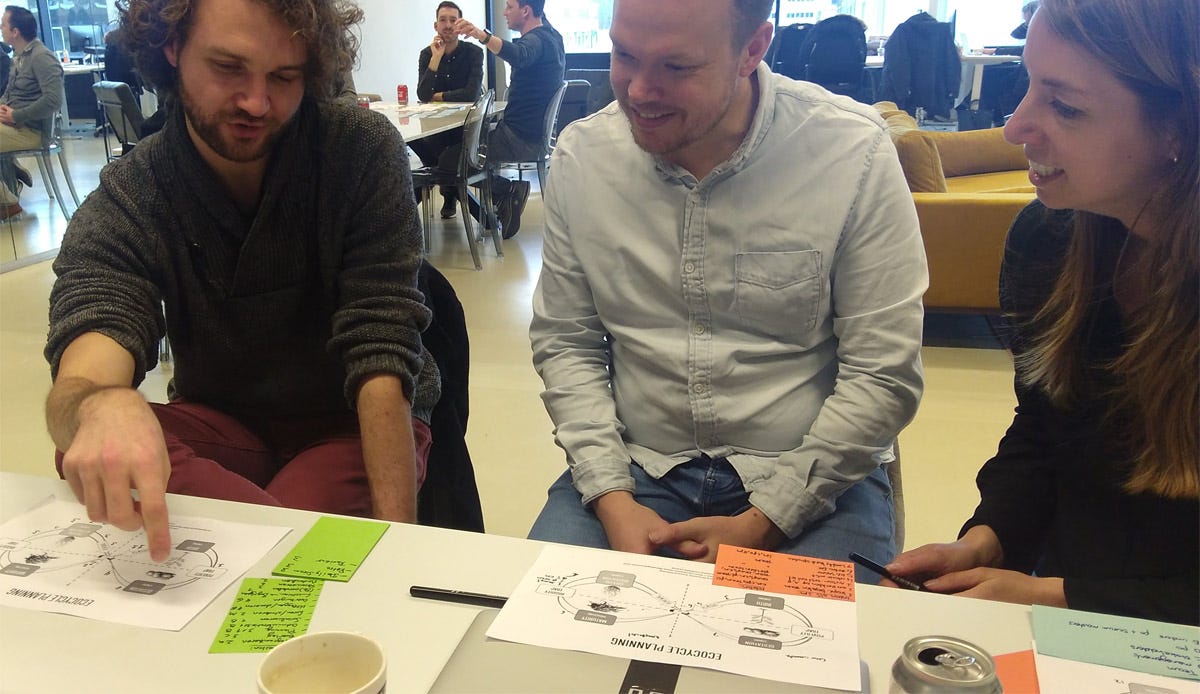Create Focus With Ecocycle Planning
With only so much time and finite resources, every business needs a way to determine if the work they are doing bringing appropriate value.
Join the DZone community and get the full member experience.
Join For FreeHow often have you found yourself juggling too many balls? You may start dropping things left and right in a frantic effort to keep everything in the air. You will also find yourself unable to pick up new balls as it will only add stress and chaos. This may happen to you personally. Or in your team. Or in your entire organization.
Ecocycle Planning is about exploring what it is that you’re keeping in the air (but shouldn’t), and what it is that you aren’t (but should)
In these situations, we have to rediscover our focus and creatively ‘destroy’ what isn’t valuable anymore. The Liberating Structure Ecocycle Planning is about exploring what it is that you’re keeping in the air (but shouldn’t), and what it is that you aren’t (but should). You can do this individually or with a group of people.
A Metaphor from Nature and An Example
The name of this Liberating Structures borrows from the ecological cycle of life. Plants, for example, grow from seeds when they land in fertile ground (incubation). When the ground is fertile enough, seedlings will sprint that in turn depend on sufficient sun, shelter and minerals to grow (birth). When these conditions have been met, seedlings grow into plants that bear fruits and/or spread new seeds (maturation). But eventually, even mature plants die and are composted to become energy for new plants. Or their removal simply makes place for new seeds to grow (creative destruction).

Download a PDF-version of this image
The work that we do in daily life can be plotted onto this cycle. We often embark on activities that may become valuable at some point, but require our energy and time to grow. Other activities are more mature in that we can do them without much effort to get a lot of value out of them. But as with plants, sometimes we need to stop activities (destroy them) to make space for something new in our agenda’s. Still to vague? Below is an example of an Ecocycle Planning for The Liberators:

The Ecocycle model adds two dimensions:
- Some activities may get stuck in the Poverty Trap or the Rigidity Trap. The first holds the activities that aren’t getting the energy and time they need to grow into something valuable, while the second holds the activities that are costing us energy and time while their value is diminished or diminished;
- As in nature, ecocycles are multi-layered in that every activity on the ecocycle contains another ecocycle, only on a lower level. So one ecocycle may describe your personal hobbies or all the products you’re working on as a team. A lower-level ecocycle can describe the activities you perform for one specific personal hobby or one particular product that you’re working on. This layering also emphasizes that everything is related. Change on one level impact activities on other levels;
Uses in Scrum
Ecocycle Planning is remarkably useful for any group of people. But we’ve used them with Scrum Teams for the following:
- Cleaning up a Product Backlog or an entire portfolio of products together with a representation (or everyone) involved with the product(s);
- Personal development and coaching;
- Plotting the activities that Scrum Teams do and to discover what they should spend more time on. And most importantly, what to let go of;
- Helping Scrum Masters and Product Owners develop themselves. What are they spending a lot of time on that isn’t delivering value?;
- Plotting all kinds of meetings that people have to attend and weeding out what isn’t helpful and investing in what is;
- Combine the creating of a stakeholder-map with an Eco-cycle. What are the relationships we should invest in more or let go off?

An example of a Group Ecocycle (by Nancy White)
Steps (~60 min)
The steps of this structure are detailed below. The timeboxes are indicative. We are offering an example of how you would do an Ecocycle Planning with groups. But they need only a few tweaks for individuals.
- Introduce Ecocycle Planning. Explain the metaphor with an example, preferably a personal one. If you’re doing a group Ecocycle, bring a large version (the larger the better) or model it on the floor. You can hand-out printouts of the Ecocycle to help people understand the model (5 min);
- Invite people to individually, and in silence, generate a numbered list of activities that occupy their time (5 min);
- Invite people to work in pairs to share and plot the activities on the Ecocycle (5 min);
- Invite the pairs to pair up to form small groups and have them share and finalize the placement of activities and write them on stickies (10 min);
- Invite the small groups to put their stickies on the larger Ecocycle that they share with all the other groups (5 min);
- Use 1–2–4-ALL to have the small groups to focus on activities for which there is consensus among the groups and to reflect on the patterns that emerge out of the distribution of all the stickies. Ask: “What do we need to creatively destroy or stop to move forward? What do we need to invest in?”(15 min);
- Invite the small groups to identify first-action steps or 15% Solutions that can help stop activities in the Rigidity Trap (10 min). Repeat for items in the Poverty Trap when you have the time (10 min);
- If you have the time, invite the small groups to explore activities for which there is no consensus. When possible, identify first-action steps (10 min);
Combinations
A single Liberating Structure is helpful. But their true power becomes apparent when you combine them into strings. Here are some potential variations:
- Follow-up with a 1–2–4-ALL, 15% Solutions or 25/10 Crowd Sourcing to discover strategies and first steps that can help stop activities that are in the rigidity trap or reignite activities in the poverty trap;
- Follow-up with a What, So What, Now What to identify patterns and discover meaning and actions together;
- When using Ecocycle Planning on an individual level, follow-up with Troika Consulting to give and get help;
- Precede with a Nine Whys to first clarify the purpose of the group. Then identify all the activities and the work that the group does in order to achieve that purpose. Or simply use the purpose statement generated during Nine Why’s to help the group identify what is valuable and what isn’t;
- Embed within a Panarchy to emphasize and explore ecocycles on many levels and how they interact.

A group of Scrum Masters engaged in a personal Ecocycle Planning. Other groups of Scrum Masters are sharing their Ecocycles in the background.
Tips
- Include people with different perspectives and different stakes. This helps create a more complete picture;
- If you use small-scale versions of the Ecocycle (like A4 or letter), invite people to number the activities and put the numbers in the model rather than the activities. This leaves more space and makes it easier to identify patterns;
- Bring a personal example of an Ecocycle. People often struggle with the quadrants and the abstractness of the model. An example helps. But it also helps to emphasize that it isn’t about getting it 100% right;
- If you’re daring, you can plot people instead of activities. This can help you identify the relationships that are starving and those that may be getting in the way as they are now. Rather than ending relationships that aren’t helpful, you can use the Ecocycle Planning to discover which relationships may be in need of a shake-up in their dynamic in order to become fruitful again.
Closing
In this post, we’ve explained one of the more complicated Liberating Structures called Ecocycle Planning. It helps to bring clarity in your activities as an individual or as a group of people and helps to identify where your energy and time you should go. As such, it is a foundational structure that you can use periodically to reflect and refine your work. We’re always happy to hear your experiences or hear your suggestions.
If you’d like to know more about Liberating Structures or experience a large number of them first-hand, make sure to join our Immersion Workshop in Amsterdam (December 10 & 11) or one of the others taking place in Europe in that month. Or join the Dutch User Group to give and get help from other users.
Published at DZone with permission of Barry Overeem, DZone MVB. See the original article here.
Opinions expressed by DZone contributors are their own.

Comments